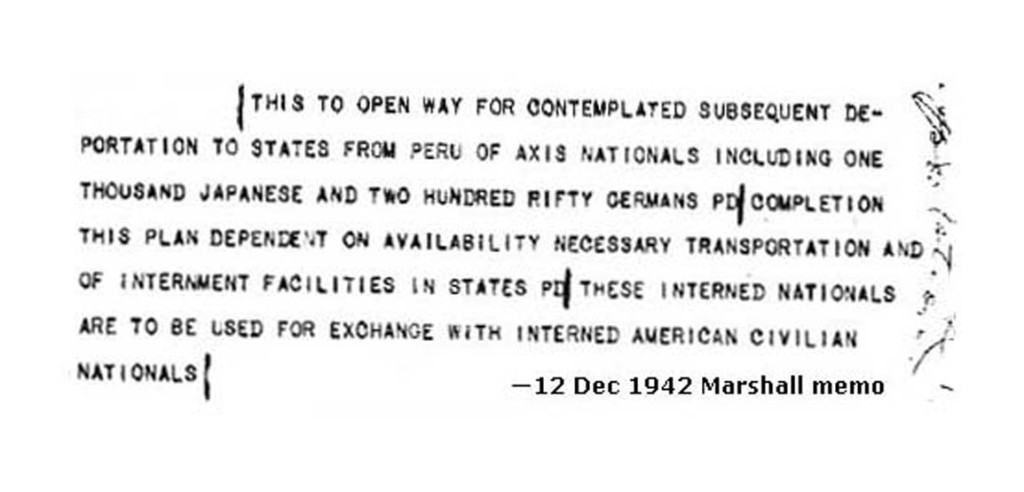LATIN AMERICAN INTERNMENT PROGRAM
HISTORY
— The Latin American Internment Program —
the Special War Problems Division of the Department of State
The United States implemented three programs to identify, imprison, and repatriate civilians considered a threat to the country during the war years; the War Relocation Authority (WRA), the Enemy Alien Control Program, and a State Department program called the Special War Problems Division in Latin America. In all three, both legal resident aliens and naturalized citizens whose ethnicity was suspect, were targeted.
The Latin American internment program is the least known. As the result of U.S. arrangements and financial support, thousands of civilians of German, Italian or Japanese ethnicity, legal residents in Central and South America as well as countries of the Caribbean, were swept into local detention centers and held without hearings or legal recourse. Conditions in which they were detained varied widely, but many were truly miserable. U.S. military ran some of the sites, such as Camp Empire, in Balboa, Panama Canal Zone, while the U.S. funded others, like Isle of Pines, Cuba. (Latin American Detention Facilities) Some countries used local prisons and penitentiaries, while in others, prisoners with wealth and connections were housed in hotels, or, as in Ecuador, were simply asked to move away from the coast to more inland areas.
In a few examples, the percent of German citizens believed expelled from Costa Rica was around 25%, in Guatemala 30%, in Colombia 20%, and more than half the Germans in Honduras. (Max Paul Friedmann, Nazis and Good Neighbors: The United States Campaign against the Germans of Latin America in World War II. New York: Cambridge University Press, 2003, 3.) Some of the prisoners and many of their families were citizens of the country from which they were expelled.
Lists from the U.S. National Archives show 1,813 prisoners sent directly on to Germany. (“German Nationals Repatriated from South and Central America.”) The true number of people deported straight from Latin American countries has yet to be determined. 4,058 Germans, 2,264 Japanese, and 287 Italians were deported to the United States with their families. These captives were housed in the Department of Justice’s Immigration and Naturalization Service (INS) camps. (White to Lafoon, 30 Jan 1946) 3,317 of these Latin American internees of German ethnicity were eventually sent to Germany. (“German Nationals Deported by the Other American Republics Who Were Deported Via the United States, 25 April 1946”)
Why did the U. S. create and administer the Latin American program?
U.S. policies were motivated by three concerns; national and hemispheric security, economic rivalry for Latin American markets, and the third, least savory purpose — gathering captives to use for barter with Axis countries holding American prisoners. While this history will focus on the experience of German Latin Americans, Japanese communities of Latin America and a limited number of residents of Italian and other ethnicities suffered similar circumstances.
1. National and Hemispheric Security
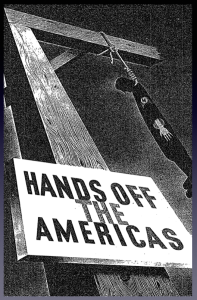
1940 cartoon—New York Times
In 1936, the President of the United States, Franklin Delano Roosevelt, worried about the growing militancy of Germany, authorized J. Edgar Hoover, head of the Federal Bureau of Investigation (F.B.I.) to identify U.S. citizens and legal residents who might pose possible future security risks. The program was secret and illegal. Because Roosevelt was also concerned that Nazi elements would become established in Central and South America, he authorized the formation of the Secret Intelligence Service to do the same in Latin America. J. Edgar Hoover officially created the S.I.S. on July 1, 1940. (Leslie B. Rout, Jr. and John F. Bratzel, The Shadow War: German Espionage and United States Counterespionage in Latin America during World War II, University Publications of America, Inc., Maryland, 1986, 28.)
Surreptitiously, the FBI had the first of its agents in place in Latin America by May, prior to that announcement. Positioned as legal or civil attachés with consulates and embassies, or as legitimate businessmen, many were poorly trained and spoke little or no Spanish, Japanese or German.
In February 1941 Adolf Berle, Assistant Secretary of State, wrote a State Department document which made indiscriminate statements labeling many Latin American German groups as subversive, indicting German commercial firms as “indispensable media for the operation of the Nazi system,” and asserting that “…virtually all the Reichsdeutschen [Germans born in Germany] in Latin America are sincere supporters of the Nazi regime” and “Virtually every non-Jewish German citizen belongs to some branch of the Nazi hierarchy.” He called for all ambassadorial and consular officers to report any suspicious Germans and activities of German commercial firms. (Adolf Berle, Memorandum to Chiefs of the Diplomatic Missions in the Other American Republics, The Pattern of Nazi Organization and Their Activities in the Other American Republics. 6 Feb. 1941, decimal file 862.20210/414A, 250/34/7/4, Box 5505, RG 59, NA.)
Coded as strictly confidential, the document was sent to Latin American embassies and soon reports came pouring in of people “believed to possess Nazi sympathies” from “sources generally considered to be reliable.” The stage was set for the sweeping arrests and imprisonments that followed.
U.S. officials were urged to pressure the countries in which they were based to arrest and intern Axis citizens, but were to do it in a subtle, secretive way that could not be traced back to the U.S. In Costa Rica, a written memo was sent by the U.S. Embassy to the Costa Rican Foreign Office, listing people approved by Enemy Alien Control officials in the U.S. for deportation and internment in the U.S. J.M. Cabot, chief of the Central America Division wrote to officials;…”we should rap the Embassy sharply over the knuckles for such an indiscreet act.” (Department of State memos, Nov. 1943)
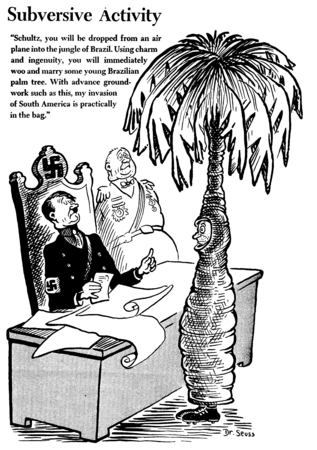
Subversive Activity, July 30, 1941, Dr. Seuss Political Cartoons. Special Collection & Archives, UC San Diego Library
A conference of Western Hemisphere countries met in Rio de Janeiro January 15-28, 1942. By then most Latin American republics had severed Axis diplomatic ties or entered war on the Allied side. At the insistence of the United States, an Emergency Advisory Committee for Political Defense was created to monitor “alien enemies” in Latin America, requiring registration, increasing surveillance, limiting internal travel, and forbidding aliens to have guns and transmitters, (though radios without transmitting capacities were also seized), the same restrictions then in place in the United States. Naturalization procedures were to be slowed, so aliens could not become citizens. Detention was urged and cancellation of citizenship was recommended for any native-born or naturalized citizen who supported the Axis powers in any way. The first arrests and deportations quietly began. (Schofield to Attorney General, 27 Mar 1942)
Under intense pressure from the United States, eighteen Latin American countries, many of them in the Caribbean area, Central America and northern South America, took advantage of U.S. willingness to subsidize the imprisonment and deportation program. Mexico, Venezuela and Brazil began internment programs of their own, while Chile, attempting to stay neutral, used its own legal system to deal with Germans considered a threat. Germans residing in Argentina remained largely untouched, because the government tended to be pro-fascist. (White to Lafoon, 30 Jan 1946) In 1943, in Montevideo, the Emergency Advisory Committee adopted U.S. Department of Justice/State Department resolutions to allow the United States to provide detention accommodations and shipping expenses for Latin Axis nationals to the United States, a process already underway for the past eighteen months. (21 May 1943, Resolution Concerning Detention and Expulsion of Dangerous Axis Nationals)
The authors also noted a change in policy. The U.S. originally deported only males, leaving women and children behind. But this procedure had failed, since the families, left without means, complained to local authorities and “have become a very dangerous focus of anti-United States propaganda.” The new recommendation was to deport everyone in the family. By November 1942 a secret memo was written and distributed to all U.S. diplomatic posts in Latin America, detailing the work being done to remove aliens. Since “all German nationals without exception, all Japanese nationals, a small proportion of Italian nationals, and more individuals than might be expected among the political and racial refugees from Central Europe are all dangerous,” suggestions of methods that might be used to improve the numbers being deported were included. (Memorandum Regarding the Activities of the United States Government.)
Was the Administration right to be so concerned about Nazi infiltration in Latin America?
Fears that Germany might seize power in some Latin American countries and then stage incursions into the U.S. were not unrealistic. Germany was a strong, militant country rapidly annexing new territories by force, and reports from the Office of Strategic Services (forerunner to the Central Intelligence Agency), F.B.I. and the British Security Coordination all indicated at least some level of Nazi activity in Latin America. For national security, continued U.S. control of the Panama Canal was essential, since it provided convenient passage between the Atlantic and Pacific oceans, where the United States was fighting simultaneous battles.
Certainly, culture, family and affection to their motherland linked many of the German Latin Americans. Some were generally supportive of the increasingly militaristic stance taken by Germany, while others became vociferous exponents. But most were Latin Americans first and foremost, no matter what their citizenship. Far from their birthplaces, they had made homes in their country of choice and that was where their true loyalty lay.
Realistic evaluation of the potential threat posed by fascist efforts in Latin America was hampered by inaccurate and sometimes intentionally misleading reports and news stories. Agents sent to collect information used paid informers and anonymous tipsters. Histrionic claims were produced, and believed by some, that all Germans residing in Latin America actively supported Hitler’s policies. United States officials made the erroneous assumption that ethnicity alone decided loyalty. Once that assumption was in place, all Germans became the enemy. (For more, see “German Clandestine Activities in South America in World War II” by David P. Mowrey. The National Security Agency report details both German and U.S. activities in Latin America.)
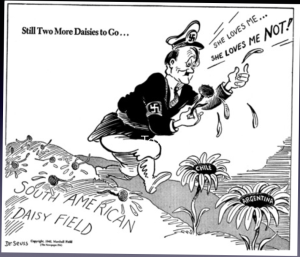
23 Jan 1942, Dr. Seuss Political Cartoons—Special Collection & Archives, U.C. San Diego Library
2. Economic Considerations
Military security was not the only United States motive for increasing intervention in Central and South America. Control of Axis owned businesses was desirable to block the possible use of their profits for Nazi support, but another aim was to eliminate competition with United States companies. Covert U.S. arrangements with some countries led to the removal of German management and personnel of airlines in Colombia in 1939, and in Ecuador, Bolivia, and Chile over the next few years, and the rise of United States companies to fill the gaps. (Stephen Fox, “The Deportation of Latin American Germans, 1941-47: Fresh Legs for Mr. Monroe’s Doctrine,” Yearbook of German-American Studies, vol. 32, 1997, 121-22 and Friedman, Nazis and Good Neighbors, 106-107.)
Following the lead of the British, who, in August 1940, had published a list of Axis citizens and businesses to be boycotted economically, the State Department, in June 1941, ordered its delegations in Latin America to gather information for similar restrictions by the United States. Franklin Delano Roosevelt’s Proclamation 2497 on July 17, 1941 declared “The Proclaimed List of Certain Blocked Nationals,” people and businesses whom the United States would no longer deal with economically. This effectively prevented any company from dealing with them since it, too, would be placed on the list if it did so. It also paved the way for U.S. businesses to take over blacklisted companies. El Salvador Lista Negra (blacklist), courtesy of Margret de Oliveira Castro. Costa Rican blacklist, courtesy of Gurcke family.
3. Bargaining Chips
The third motive was clearly stated in the internal State Department memo of November 1942. The “Nations of Central America and the Caribbean islands [sic] have in general been willing to send us subversive aliens without placing any limitation on our disposition of them. In other words, we could repatriate them, we could intern them or we could hold them in escrow for bargaining purposes.” It goes on; “It is particularly desirable that the repatriation of inherently harmless Axis nationals may be used to the greatest possible extent” to obtain release of Allied citizens in Axis countries. “Inherently harmless” people being imprisoned and exchanged clearly demonstrates that security of the western hemisphere was not the sole U.S. motive. (Memorandum regarding the Activities of the United States Government.)
By December 1942 another secret memo discussed plans to bring captured Latin Americans to the United States for temporary internment. “Completion this plan dependent on availability necessary transport and of internment facilities in States. These interned nationals are to be used for exchange with interned American civilian nationals. …” (Marshall memo, Dec. 1942)
Were Jews among the internees?
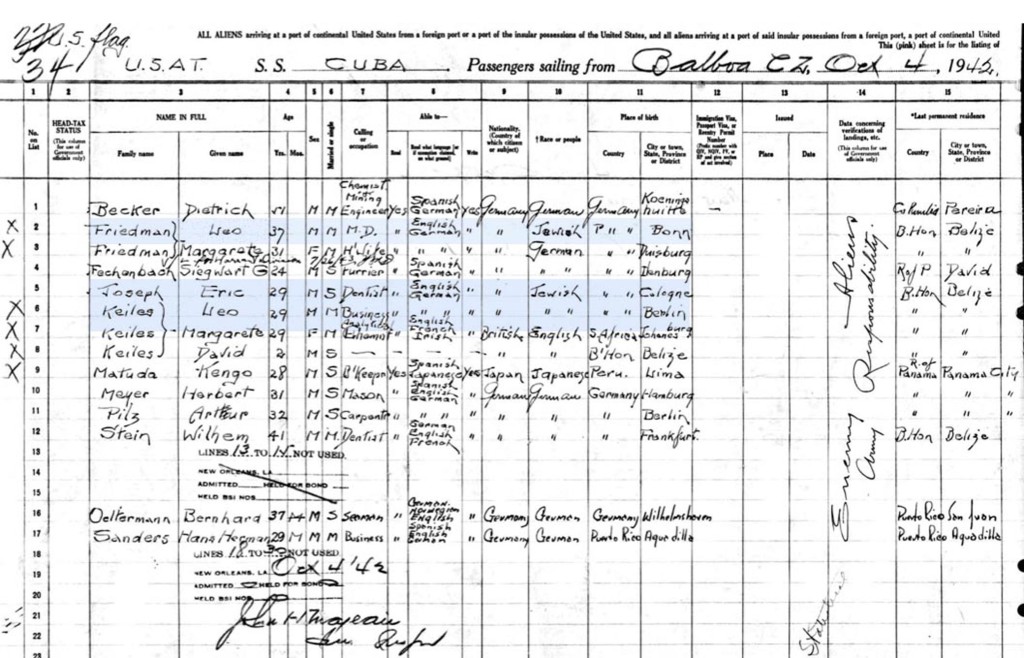
USAT Cuba-Oct 1942 manifest—sailing from Balboa, Canal Zone, to New Orleans, Florida for internment
The November 1942 State Department memorandum that talked of inherently harmless people being exchanged, also addressed racial and political refugees in Latin America, noting that they “…in general attract sympathy and it is difficult for the general public and even some Governmental agencies to realize the diabolical cleverness of the Axis Governments in concealing their own agents in groups of genuine refugees.” Even when refugees produced documents to show that they had been in concentration camps or had otherwise been persecuted, it was not considered proof of innocence.
81 Jews were noted to have been brought to the U.S. from Latin America. (Arnold Krammer, Undue Process: the Untold Story of American’s German Alien Internees, Maryland: Rowman and Littlefield Publishers, Inc. 1997, 98-99.) Of 247 Germans brought up from Panama between 1941-1945, 30 were Jewish, and of these five had spent time in Nazi concentration camps. (Friedman, Nazis and Good Neighbors, 110.) “Jewish Internees in the American South, 1942-1945,” by Harvey Strum; American Jewish Archives Journal.
In a Feb 1943 letter exchange between Jewish internees being held at Camp Kenedy, Texas and W. Bruppacher, Department of German Interests, Legation of Switzerland, charged with camp inspection and oversight of internees of German ethnicity, they express concerns about finances, censorship, and the difficulties of living “close to our worst enemies.”
Two of the Jewish Germans may have been repatriated to Germany, probably willingly, according to Friedman (203, note 58). Some formerly repatriated German Americans and Latin Americans report that they knew Jews who were sent back unwillingly, but this has not been corroborated.
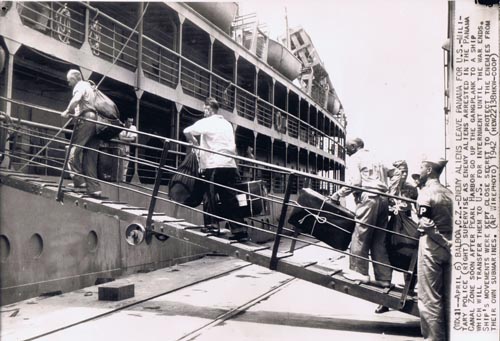
6 April, 1942—Enemy Aliens leave Panama for U.S. internment. (courtesy Associated Press)
Deportation to the United States was an ordeal.
The United States assembled an assortment of military and privately owned vessels to collect prisoners and their families at various ports. All baggage and the token amount of money deportees were allowed to have was confiscated, as were visas and passports. When luggage was returned at the end of the journey, prisoners often found possessions stolen.
Krammer (Undue Process, 94) lists the following vessels used: Cuba, Etolin, Florida, Acadia, USAT General Ernest, USAT General Gordon, USAT General Meigs, USAT General Randall, SS Imperial (Chilean), USAT Madison, SS Matsonia, USAT Puebla, Shawnee (Atlantic Gulf and West Indies Steamship Company) and the USAT Colonel Frederick C. Johnson. (sample ship manifests and photos)
Ship crews were often surprised to find women and children among the prisoners. Sanitary facilities were inadequate and quickly overwhelmed. Cabins overflowed with restless, runny-nosed children; bare mattresses covered all floor space, and diapers, rinsed when possible, were hung to dry wherever practical.
“The Acadia, with cabin space for 200 passengers, took on board a total of 675 Axis nationals from Peru, Ecuador, and Colombia on its northward journey, resulting in ‘unimaginable overcrowding,’ food shortages, and a lack of bathing facilities.” (Friedman, Nazis and Good Neighbors, 116.)
When the USAT (United States Army Transport) Colonel Frederick C. Johnson sailed from Peru, women and children were assigned bunks, without guard rails, in tiers of four in an approximately fifty by forty foot space. There was only one latrine for use by all prisoners, and women and children had to go through the men’s holding area to get there. Inadequate water supplies meant no water for bathing or washing, and drinking water was unavailable for much of the night. (Gardiner, C. Harvey. Pawns in a Triangle of Hate. Seattle: University of Washington Press, 1981, 107-108.)
On the USAT Puebla transporting Costa Rican families to the U.S. in January 1943, original arrangements for families’ meals proved unworkable, when weary mothers were unable to feed over-excited, cranky children and themselves in the 15-20 minutes allowed. Cabins soon stank of unwashed bodies, vomit and dirty diapers. The men in the hold experienced even worse conditions. (See 22 Feb 1943 letter describing conditions)
Children sickened from poor sanitation, confined quarters and overcrowding. By the time the Puebla’s human cargo reached San Pedro, California for interrogation and processing, numerous children and adults had sores with oozing, yellow exudate on hands and faces. Many were seriously ill as well, with severe coughs and high fevers.
Immigration and Naturalization (INS) Quarantine Stations
The prisoners brought up from Latin America debarked at Immigration and Naturalization (INS) quarantine stations. Algiers, Louisiana received many of the exhausted travelers, while others landed at Terminal Island, San Pedro, California. These facilities, like other stations, processed new arrivals for shipment elsewhere, and also served as holding sites for others. At the Algiers station, new arrivals were stripped, showered, and then sprayed with insecticide. (28 Mar 1944 letter, Bannerman to Fitch)
FBI and INS interrogations of some of the prisoners followed, while all those deported were subjected to hearings to determine their right to enter the U.S. Because their passports and papers had been confiscated on shipboard, they were charged with entering the United States illegally once they set foot on American soil. This accusation provided the rationale for detaining them indefinitely. Post-war, the same assertion was used to justify sending these men, women and children to war torn Germany or Japan, rather that allowing them to return to their homes in Latin America. (See Atlantida manifest of June 1942, page one, with handwritten notes indicating prisoners were not provided visas on instruction of the Department of State.)
Once processed through the quarantine stations, some German Latin Americans continued to be held at Algiers, though most were sent on to Department of Justice (DOJ) camps: Kenedy, Crystal City and Seagoville, all in Texas; Ft. Lincoln, North Dakota and Ellis Island, New York. Crystal City housed the majority of the families interned. U.S. Army Detention Facilities were also used, such as Stringtown, Oklahoma, Fort Ogelthorpe, Georgia, Fort Meade, Maryland and Camp Blanding, Florida. (Internment Camps)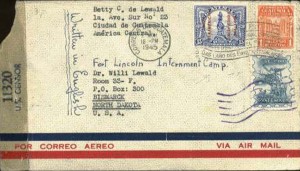
When the prisoners from the Puebla reached Crystal City, TX for internment, “[they] arrived with forty cases of whooping cough and an epidemic of impetigo. Fortunately, the camp was not yet crowded, and it was possible to isolate the entire party.” (O’Rourke, Joseph L. Historical Narrative of the Crystal City Internment Camp, a report to W.F. Kelly, Assistant Commissioner for Alien Control Office, Immigration and Naturalization Service, Crystal City Internment Camp,RG 85, 101/161, 32, NA, 21.)
Another group of Latin American internees, arriving at Crystal City in July 1944, brought with them a second epidemic, measles. In spite of quarantine and intensive medical care, one person died. (O’Rourke, Historical Narrative, 24.) See also: “Medical Care for Interned Enemy Aliens: A Role for the US Public Health Service in World War II” by Louis Fiset, DDS, BA, American Journal of Public Health.
“Nothing was very comfortable, but…you see there was a war going on, and everything we did had to do with the war.” Starr Pait Gurcke, former Costa Rican internee, speaking through her tears in a 1994 interview. (Gurcke Family Story)
Repatriation—A Choice?
Throughout the war, both German American and Latin American internees were offered, even pressured to accept, passage to Germany. There is evidence that most, but not all repatriations were voluntary. (Friedman, Nazis and Good Neighbors, 206-208.) Why would internees choose to go to Germany, when most had left their native country years before, and their wives and children were American or Latin American?
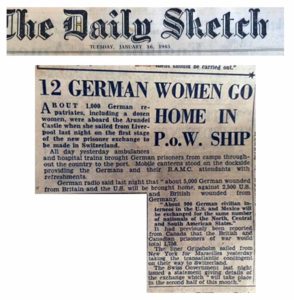
1945 British article on repatriation and exchange “About 400 German civilian internees from the U.S. and Mexico will be exchanged…” (courtesy Cornelia Mueller)
Recent experiences in their adopted countries and in the United States caused bitterness and predictably deepened feelings of alienation for some. Others simply preferred freedom to indefinite detention. Gunther Graber, a former internee from the United States, says it best; “Choosing so-called ‘voluntary’ repatriation to war-torn Germany is ample evidence of how miserable, embittered and discouraged my father was. Let no one say that under such circumstances, repatriation was in any way truly voluntary. ”
(See “German Nationals Deported by the Other American Republics Who Were Deported Via the United States, 25 April 1946”; See also: Graber Family Story) (photographs of some ships used for repatriation voyages) (letter enumerating German Latin American civilians and wounded German soldiers on board the Feb 1944 Gripsholm voyage)
As the War Winds Down
In November 1945 a Department of State press release was sent to all Latin American internees, regarding “the disposition” of enemy aliens who had been brought to the U.S. from other American republics. Many had been repatriated but there remained “a considerable number of others, including many who were leaders in anti-American activities, [who] now decline to return to their native countries, wishing to move back to Latin America or to remain here.”
The press release mentions that a meeting of all American republics at a conference in Mexico City the prior year “included a recommendation that measures be taken ‘to prevent any person whose deportation was deemed necessary for reasons of security of the Continent from further residing in this Hemisphere, if such residence would be prejudicial to the future security or welfare of the Americas.’ Pursuant to that recommendation, on September 8, 1945, the President of the United States [Harry S. Truman] by Proclamation 2662, authorized the Secretary of State to order the repatriation of dangerous alien enemies deported to this country during the war.
…“In proceeding with this program the Department intends to follow an orderly procedure wholly consistent with American concepts of fairness and equity.” Cases were to be reviewed “with a view to releasing as quickly as possible those persons who may safely be allowed to remain in this Hemisphere.”
A January 1946 bulletin sent by the State Department answered the question “By what authority am I being held in custody?” with the following explanation; “You are being held in custody under the authority of the Alien Enemy Act…which gives the President of the United States power to confine and deport natives or citizens of an enemy country in time of war. You will note that a state of war still exists between the United States and its enemies, since no peace has yet been signed.” (See Department of State memorandum, January 4, 1946 with Notice to Internees from Latin America.)
Before the war was truly over, Germans who had been brought to the U.S. for internment and remained there began to receive arrest warrants, asserting that they had entered the country without appropriate papers and were therefore in the country illegally. (Arrest Warrant)
However, attempts to repatriate all German Latin Americans were beginning to falter. Some Latin American countries wanted all their German residents returned; others wanted specific individuals. Government officials and agencies were no longer unanimously in favor of ridding the Western Hemisphere of “Nazis,” especially since a secret government program was bringing into the U.S. German engineers, scientists and technicians. 50-80% of them were former Nazi Party members and some, like Klaus Barbie, known as the butcher of Lyon, were guilty of war crimes.
 Then too, inconveniently for the U.S., remaining internees were bringing more suits against the government —and winning. Helmuth Sapper, from Guatemala, finally had his day in court on December 20, 1945. The judge, in his verdict, stated; “That a government can go into another country and transport a man against his will thousands of miles across the sea… is repulsive. …If this situation were to become generally known, it would be subject to severest criticism.” (See also: Sapper Family Story) In September 1947, the last of the German Latin Americans imprisoned in the U.S. were ordered released. (Friedmann, Nazis and Good Neighbors, 226-227.)
Then too, inconveniently for the U.S., remaining internees were bringing more suits against the government —and winning. Helmuth Sapper, from Guatemala, finally had his day in court on December 20, 1945. The judge, in his verdict, stated; “That a government can go into another country and transport a man against his will thousands of miles across the sea… is repulsive. …If this situation were to become generally known, it would be subject to severest criticism.” (See also: Sapper Family Story) In September 1947, the last of the German Latin Americans imprisoned in the U.S. were ordered released. (Friedmann, Nazis and Good Neighbors, 226-227.)
The Aftermath
Most people now agree that United States’ measures against perceived enemies were much too sweeping in the Second World War, broadly targeting certain ethnic groups without adequate proof of guilt. A commission has already judged as misguided and racist the Japanese American detention programs. President Bill Clinton offered Japanese communities in Latin America, particularly Peru, a public apology and some compensation in 1998. The Wartime Treatment Study Act, which would have created the first independent review and evaluation of United States policies directed against European ethnic groups, was re-introduced for the fourth time in the 111th Congress, March 2009. Congress did not vote on the Act, so it died at the end of the session, leaving the last two U.S. World War II civilian detention policies—the Enemy Alien Control and Latin American State Department programs—unexamined.


